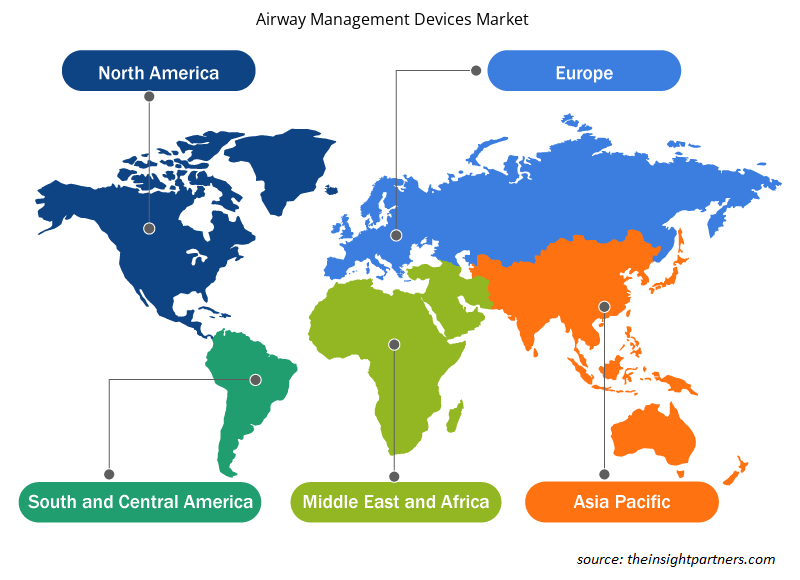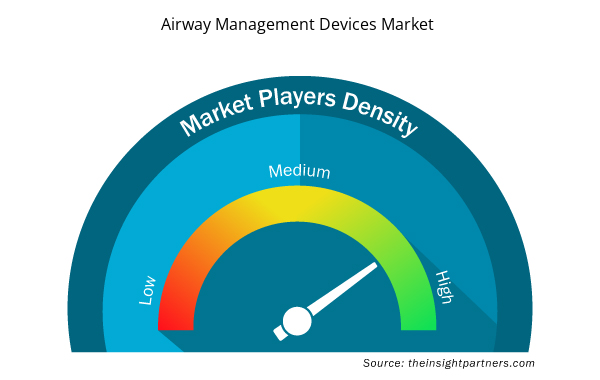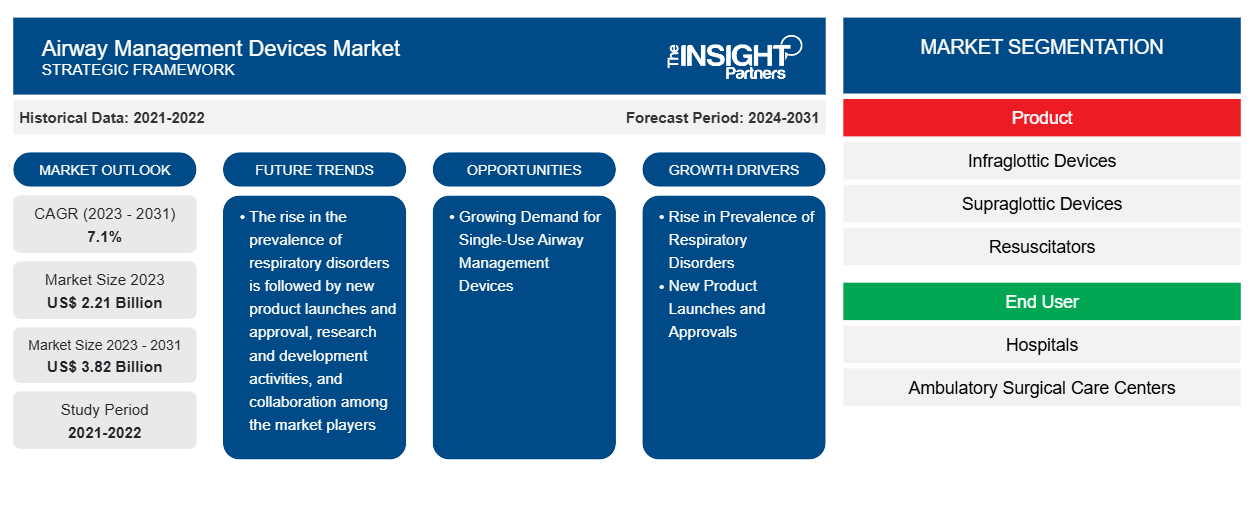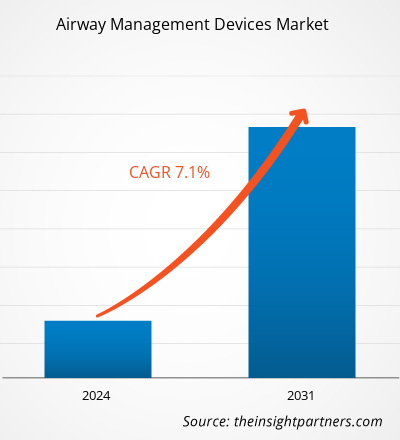气道管理设备市场规模预计将从 2023 年的 22.1 亿美元增至 2031 年的 38.2 亿美元。预计 2023-2031 年期间市场复合年增长率将达到 7.1%。呼吸系统疾病患病率上升,随之而来的是新产品的推出和批准、研发活动以及市场参与者之间的合作,这些可能仍是市场的主要趋势。
气道管理设备市场分析
由于有害环境和职业及有毒行为吸入的增加,慢性呼吸系统疾病是全球最常见的非传染性疾病。这类疾病包括慢性阻塞性肺病 (COPD)、哮喘、肺结节病、间质性肺病和尘肺(如矽肺和石棉肺)。根据世界卫生组织 (WHO) 的数据,COPD 是全球第三大死亡原因。《2019 年全球哮喘报告》指出,全球约有 3 亿人患有哮喘,预计到 2025 年这一数字将激增 1 亿。根据世卫组织的报告,2019 年哮喘影响了全球 2.62 亿人,导致 455,000 人死亡。此外,2019 年,哮喘导致美国每年有 439,000 人住院,估计有 130 万人次就诊。呼吸系统疾病的发病率不断上升,推动了全球对气道管理设备的需求。因此,上述因素正在推动气道管理设备市场的发展。
气道管理设备市场概况
气道管理设备投资和资金的增加、初创公司数量的增加以及技术进步是市场增长的主要驱动力。然而,市场的增长受到各种因素的限制,例如缺乏熟练的专业人员和漫长的审批流程。基因合成在日本等一些地区是一个成熟的市场,而随着印度、中国、印度尼西亚和台湾等国家最近取得的一些进展,预计大部分需求将来自上述国家。此外,日本和印度对行业参与者的重视程度不断提高以及中国等国家的资金补助等因素可能会推动市场的增长。
定制此报告以满足您的需求
您可以免费定制任何报告,包括本报告的部分内容、国家级分析、Excel 数据包,以及为初创企业和大学提供优惠和折扣
- 获取此报告的关键市场趋势。这个免费样品将包括数据分析,从市场趋势到估计和预测。
气道管理设备市场驱动因素和机遇
呼吸系统疾病患病率上升利好市场
全球大量人口中各种慢性疾病(如慢性阻塞性肺病、哮喘、囊性纤维化和肺气肿)的发病率不断上升,这推动了全球范围内的产品发布、新产品开发和审批。此外,大多数市场竞争对手都专注于研发活动,以确保发明和开发高效的产品。2022 年 7 月,Verathon 宣布推出 BFlex 2.8 一次性支气管镜。BFlex 一次性支气管镜专为满足 ICU、OR 和 ED 的关键需求而设计。BFlex 2.8 是 Verathon 的第一款一次性儿科支气管镜,可提供儿科支气管镜检查、气道管理和肺隔离程序所需的可操作性和图像质量。此外,2021 年 5 月,奥林巴斯公司获得了 FDA 510(k) 批准,其气道移动内窥镜 MAF-TM2、MAF-GM2 和 MAF-DM2 可让供应商执行各种上、下气道管理程序。因此,产品开发、批准和发布的增加可能会在不久的将来推动气道管理设备市场的发展
一次性气道管理设备需求不断增长
全球医疗设施和服务的显著发展增加了对各种产品的需求,包括一次性设备。如今,一次性设备在全球范围内被广泛使用,因为它具有多种好处,例如提高患者安全性、减少医院相关感染以及更好地管理呼吸道传染病。一次性气道管理设备经过预先消毒,可直接使用,节省了大量的清洁和消毒时间。这些设备广泛用于处理患有严重传染性疾病的患者,例如严重肺炎和 H1N1 流感。此外,COVID-19 大流行创造了对一次性气道管理设备的需求,用于治疗 COVID-19 患者,这有望进一步减少感染的传播。此外,严重的 COVID-19 病例需要呼吸机支持和插管,这增加了一次性气管导管的使用。
此外,心脏病发作、中风、呼吸困难和致命交通事故等紧急情况的增加,以及容易患呼吸系统疾病的老龄人口负担的增加,预计将创造增长机会。此外,政府机构为改善急救基础设施和服务而投入的研发投资和资金激增,预计将在未来几年为市场增长创造机会。
气道管理设备市场报告细分分析
有助于得出气道管理设备市场分析的关键部分是产品和最终用户。
- 根据产品和服务,气道管理设备市场分为声门下设备、声门上设备、复苏器、喉镜和其他。声门下设备部分在 2023 年占据了较大的市场份额。
- 就最终用户而言,市场分为医院、门诊手术护理中心和其他。医院部门在 2023 年占据了相当大的市场份额。
气道管理设备市场份额(按地区)分析
XYZ市场报告的地理范围主要分为五个地区:北美、亚太、欧洲、中东和非洲、南美和中美。
北美占据了市场主导地位。在北美,由于呼吸系统疾病发病率不断上升,美国在气道管理市场占据主导地位,这被认为将在未来推动该市场的增长。目前,慢性阻塞性肺病 (COPD) 和哮喘是美国的主要健康负担。哮喘是一种因气道变窄和阻塞而导致慢性炎症的肺部疾病。吸烟是美国 COPD 的主要原因。美国吸烟率的上升正在推动气道管理设备市场的增长。根据美国疾病控制和预防中心 (CDC) 的数据,2020 年,美国约有 5.0% 的成年人被诊断患有肺气肿、COPD 或慢性支气管炎。预计亚太地区未来几年的复合年增长率最高。
气道管理设备市场区域洞察
Insight Partners 的分析师已详尽解释了预测期内影响气道管理设备市场的区域趋势和因素。本节还讨论了北美、欧洲、亚太地区、中东和非洲以及南美和中美洲的气道管理设备市场细分和地理位置。

- 获取气道管理设备市场的区域特定数据
气道管理设备市场报告范围
| 报告属性 | 细节 |
|---|---|
| 2023 年的市场规模 | 22.1亿美元 |
| 2031 年市场规模 | 38.2亿美元 |
| 全球复合年增长率(2023 - 2031) | 7.1% |
| 史料 | 2021-2022 |
| 预测期 | 2024-2031 |
| 涵盖的领域 | 按产品
|
| 覆盖地区和国家 | 北美
|
| 市场领导者和主要公司简介 |
|
气道管理设备市场参与者密度:了解其对业务动态的影响
气道管理设备市场正在快速增长,这得益于终端用户需求的不断增长,这些需求源于消费者偏好的不断变化、技术进步以及对产品优势的认识不断提高等因素。随着需求的增加,企业正在扩大其产品范围,进行创新以满足消费者的需求,并利用新兴趋势,从而进一步推动市场增长。
市场参与者密度是指在特定市场或行业内运营的企业或公司的分布情况。它表明在给定市场空间中,相对于其规模或总市场价值,有多少竞争对手(市场参与者)存在。
在气道管理设备市场运营的主要公司有:
- 泰利福公司
- 史密斯医疗
- 美敦力
- 英特外科有限公司
- 安布公司
- 美德莱恩工业公司
免责声明:上面列出的公司没有按照任何特定顺序排列。

- 了解气道管理设备市场主要参与者概况
气道管理设备市场新闻和最新发展
通过收集来自一手和二手研究的定性和定量数据来评估气道管理设备市场,其中包括重要的公司出版物、协会数据和数据库。以下列出了气道管理设备市场的一些发展情况:
- 全球领先的医疗技术提供商 Teleflex Incorporated 宣布与深圳 Insighters 医疗技术有限公司建立合作伙伴关系,成为 Insighters 视频喉镜系统的美国独家经销商,该系统旨在检查上声门气道并促进气管插管。此次合作增强了临床医生每天使用的行业领先气道设备组合。(来源:Teleflex Incorporated,新闻稿,2023 年 4 月)
- Teleflex 已与 Medline Industries Inc. 达成最终协议,将全球呼吸产品组合中的某些产品线出售给该公司。(来源:GenScript Biotech Corporation,新闻稿,2021 年 5 月)
气道管理设备市场报告覆盖范围和交付成果
“气道管理设备市场规模和预测(2021-2031)”报告对市场进行了详细分析,涵盖以下领域:
- 气道管理设备市场规模及全球、区域和国家层面所有关键细分市场的预测
- 气道管理设备市场趋势,以及驱动因素、限制因素和关键机遇等市场动态
- 详细的 PEST/波特五力分析和 SWOT 分析
- 气道管理设备市场分析涵盖关键市场趋势、全球和区域框架、主要参与者、法规和最新市场发展
- 行业格局和竞争分析,涵盖市场集中度、热图分析、知名参与者以及气道管理设备市场的最新发展
- 详细的公司简介
- 历史分析(2 年)、基准年、预测(7 年)及复合年增长率
- PEST 和 SWOT 分析
- 市场规模价值/数量 - 全球、区域、国家
- 行业和竞争格局
- Excel 数据集



Report Coverage
Revenue forecast, Company Analysis, Industry landscape, Growth factors, and Trends

Segment Covered
This text is related
to segments covered.

Regional Scope
North America, Europe, Asia Pacific, Middle East & Africa, South & Central America

Country Scope
This text is related
to country scope.
常见问题
The airway management devices market size is projected to reach US$ 3.82 billion by 2031
Rise in orevalence of respiratory disorder, followed by new product launch drive the airway management devices market size
The Airway Management Devices market majorly consists of the players such Teleflex Incorporated; Smiths Medical; Medtronic; Intersurgical Ltd; Ambu A/S; Medline Industries, Inc.; Koninklijke Philips N.V.; Armstrong Medical; and Mercury Medical.
Based on geography, the airway management devices market is segmented into North America (the US, Canada, and Mexico), Europe (the UK, Germany, France, Italy, Spain, and the Rest of Europe), Asia Pacific (China, Japan, India, South Korea, Australia, and the Rest of Asia Pacific), the Middle East & Africa (the UAE, Saudi Arabia, South Africa, and Rest of the Middle East & Africa), and South & Central America (Brazil, Argentina, and the Rest of South & Central America). North America is the largest contributor to the growth of the global ENT devices market. Asia Pacific is expected to register the highest CAGR in the airway management devices market during 2023–2031
The market is expected to register a CAGR of 7.1% during 2023–2031
Trends and growth analysis reports related to Life Sciences : READ MORE..
The Insight Partners performs research in 4 major stages: Data Collection & Secondary Research, Primary Research, Data Analysis and Data Triangulation & Final Review.
- Data Collection and Secondary Research:
As a market research and consulting firm operating from a decade, we have published and advised several client across the globe. First step for any study will start with an assessment of currently available data and insights from existing reports. Further, historical and current market information is collected from Investor Presentations, Annual Reports, SEC Filings, etc., and other information related to company’s performance and market positioning are gathered from Paid Databases (Factiva, Hoovers, and Reuters) and various other publications available in public domain.
Several associations trade associates, technical forums, institutes, societies and organization are accessed to gain technical as well as market related insights through their publications such as research papers, blogs and press releases related to the studies are referred to get cues about the market. Further, white papers, journals, magazines, and other news articles published in last 3 years are scrutinized and analyzed to understand the current market trends.
- Primary Research:
The primarily interview analysis comprise of data obtained from industry participants interview and answers to survey questions gathered by in-house primary team.
For primary research, interviews are conducted with industry experts/CEOs/Marketing Managers/VPs/Subject Matter Experts from both demand and supply side to get a 360-degree view of the market. The primary team conducts several interviews based on the complexity of the markets to understand the various market trends and dynamics which makes research more credible and precise.
A typical research interview fulfils the following functions:
- Provides first-hand information on the market size, market trends, growth trends, competitive landscape, and outlook
- Validates and strengthens in-house secondary research findings
- Develops the analysis team’s expertise and market understanding
Primary research involves email interactions and telephone interviews for each market, category, segment, and sub-segment across geographies. The participants who typically take part in such a process include, but are not limited to:
- Industry participants: VPs, business development managers, market intelligence managers and national sales managers
- Outside experts: Valuation experts, research analysts and key opinion leaders specializing in the electronics and semiconductor industry.
Below is the breakup of our primary respondents by company, designation, and region:

Once we receive the confirmation from primary research sources or primary respondents, we finalize the base year market estimation and forecast the data as per the macroeconomic and microeconomic factors assessed during data collection.
- Data Analysis:
Once data is validated through both secondary as well as primary respondents, we finalize the market estimations by hypothesis formulation and factor analysis at regional and country level.
- Macro-Economic Factor Analysis:
We analyse macroeconomic indicators such the gross domestic product (GDP), increase in the demand for goods and services across industries, technological advancement, regional economic growth, governmental policies, the influence of COVID-19, PEST analysis, and other aspects. This analysis aids in setting benchmarks for various nations/regions and approximating market splits. Additionally, the general trend of the aforementioned components aid in determining the market's development possibilities.
- Country Level Data:
Various factors that are especially aligned to the country are taken into account to determine the market size for a certain area and country, including the presence of vendors, such as headquarters and offices, the country's GDP, demand patterns, and industry growth. To comprehend the market dynamics for the nation, a number of growth variables, inhibitors, application areas, and current market trends are researched. The aforementioned elements aid in determining the country's overall market's growth potential.
- Company Profile:
The “Table of Contents” is formulated by listing and analyzing more than 25 - 30 companies operating in the market ecosystem across geographies. However, we profile only 10 companies as a standard practice in our syndicate reports. These 10 companies comprise leading, emerging, and regional players. Nonetheless, our analysis is not restricted to the 10 listed companies, we also analyze other companies present in the market to develop a holistic view and understand the prevailing trends. The “Company Profiles” section in the report covers key facts, business description, products & services, financial information, SWOT analysis, and key developments. The financial information presented is extracted from the annual reports and official documents of the publicly listed companies. Upon collecting the information for the sections of respective companies, we verify them via various primary sources and then compile the data in respective company profiles. The company level information helps us in deriving the base number as well as in forecasting the market size.
- Developing Base Number:
Aggregation of sales statistics (2020-2022) and macro-economic factor, and other secondary and primary research insights are utilized to arrive at base number and related market shares for 2022. The data gaps are identified in this step and relevant market data is analyzed, collected from paid primary interviews or databases. On finalizing the base year market size, forecasts are developed on the basis of macro-economic, industry and market growth factors and company level analysis.
- Data Triangulation and Final Review:
The market findings and base year market size calculations are validated from supply as well as demand side. Demand side validations are based on macro-economic factor analysis and benchmarks for respective regions and countries. In case of supply side validations, revenues of major companies are estimated (in case not available) based on industry benchmark, approximate number of employees, product portfolio, and primary interviews revenues are gathered. Further revenue from target product/service segment is assessed to avoid overshooting of market statistics. In case of heavy deviations between supply and demand side values, all thes steps are repeated to achieve synchronization.
We follow an iterative model, wherein we share our research findings with Subject Matter Experts (SME’s) and Key Opinion Leaders (KOLs) until consensus view of the market is not formulated – this model negates any drastic deviation in the opinions of experts. Only validated and universally acceptable research findings are quoted in our reports.
We have important check points that we use to validate our research findings – which we call – data triangulation, where we validate the information, we generate from secondary sources with primary interviews and then we re-validate with our internal data bases and Subject matter experts. This comprehensive model enables us to deliver high quality, reliable data in shortest possible time.


 获取此报告的免费样本
获取此报告的免费样本